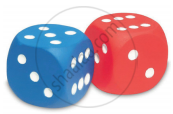Advertisements
Advertisements
प्रश्न
Two dice are rolled, find the probability that the sum is less than 13
उत्तर
Sample space (S) = {(1, 1) (1, 2) (1, 3) (1, 4) (1, 5) (1, 6) (2, 1) (2, 2) (2, 3) (2, 4) (2, 5) (2, 6) (3, 1) (3, 2) (3, 3) (3, 4) (3, 5) (3, 6) (4, 1) (4, 2) (4, 3) (4, 4) (4, 5) (4, 6) (5, 1) (5, 2) (5, 3) (5, 4) (5, 5) (5, 6) (6, 1) (6, 2) (6, 3) (6, 4) (6, 5) (6, 6)}
n(S) = 36
Let E3 be the event of getting the sum is less than 13
n(E3) = 36
p(E3) = `("n"("E"_3))/("n"("S"))`
= `36/36`
= 1
APPEARS IN
संबंधित प्रश्न
A letter of English alphabet is chosen at random. Determine the probability that the chosen letter is consonant.
A number is selected at random from the numbers 1 to 30. The probability that it is a prime number is:
(A) 2/3
(B) 1/6
(C) 1/3
(D) 11/30
Two dice are rolled once. Find the probability of getting such numbers on the two dice, whose product is 12.
A black die and a white die are thrown at the same time. Write all the possible outcomes. What is the probability?
that the numbers obtained have a product less then 16.
A number is selected at random from the numbers 3, 5, 5, 7, 7, 7, 9, 9, 9, 9 The probability that the selected number is their average is
A bag contains 4 white balls, 5 red balls, 2 black balls and 4 green balls. A ball is drawn at random from the bag. Find the probability that it is neither red nor green.
Two dice are thrown. Find the probability of the following events:
Event A : The product of the numbers on their upper faces is 10.
Event B : The sum of the numbers on their upper faces is 10
A coin is tossed. What is the probability of getting:
a tail?
In a throw of a dice, the probability of getting an even number is the same as that of getting an odd number.
Three coins are tossed simultaneously. What is the probability of getting at most one tail?
